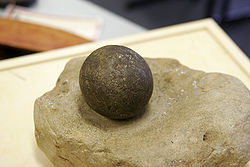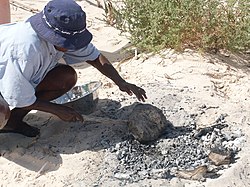AY Honors/Aboriginal Lore/Answer Key
Bush bread refers to the bread made by Australian Aborigines for many thousands of years.

With the arrival of Europeans and pre-milled white flour, this traditional bread-making process all but disappeared, although the tradition of cooking bread in hot coals continues.
Bread-making was a woman's task. It was generally carried out by several women at once, due to its labour-intensive nature. It involved collecting seasonal grasses, roots or nuts, and preparing these into flour or dough.
Bread-making from grains
Seeds varied depending on the time of year and the area in Australia that the people were located. In Central Australia, native millet (Panicum decompositum) and spinifex were commonly used. Wattleseed was also often used in the mix.
In the Kimberley region of Western Australia, women observed that, after the dry season, many seeds would be gathered around the opening of ants' nests. The ants husked the seed for them, and the women were able to collect this seed, making their job a lot easier.
Making the flour
After the grain was collected, it need to be winnowed, which was often done using the coolamon, the multi-purpose carrying vessel.
Once the grain was winnowed, it was ground using a millstone, to create flour. Millstones have been discovered which prove to be as old as 50,000 years. The flour was then mixed with water to make a dough and placed in hot ashes for baking. The results could be small buns, today referred to as johnny cakes, or a large loaf, known as damper. Damper appears to be a mix of this traditional style of bread-making and European bread-making.
The dough could also be eaten raw. Cooking was a good way to prepare the bread if the group were about to travel for some time.

Bread-making from other plant products
Bread could also be made from roots and corms of plants. In the Top End of Australia, people such as the Yolngu used the lotus root and wild taro. These were ground, then mixed to a paste to make the bread.
Water lily seed bread was also popular in the Top End. The two species of water lily used were Nelumbo nucifera and Nymphaea macrosperma. During the early part of the dry season, water lilies were an important part of the diet, with seed pods eaten raw or ground into paste.
Women had expert knowledge of how to "de-toxify" certain plant foods. The seeds of the cycad palm, Cycas media, are highly carcenogenic when raw and require elaborate treatment includuing shelling, crushing, leaching in running water for up to five days, then cooking. After this they are made into small loaves, which can keep for a number of weeks.
In Queensland, the people of the Mount Tamborine area used the Bunya Pine cone, endemic to the area, to make bread in this way.
Some names for Aboriginal bread
- Bunup
References
- Bush Bread artwork
- Grass seed artwork
- Aboriginal Technology
- Australian History
- Peterson, Nicholas, Donald Thomson in Arnhem Land, Melbourne University Press ISBN 0522850634, pp168-9
